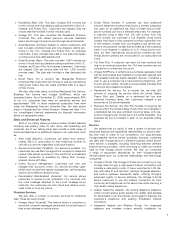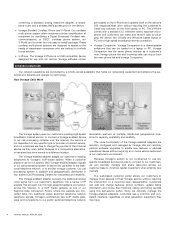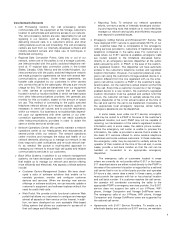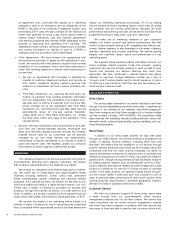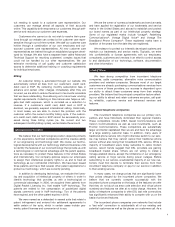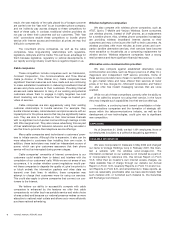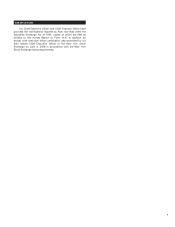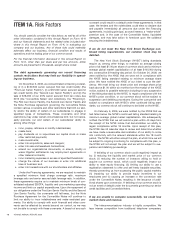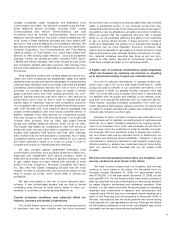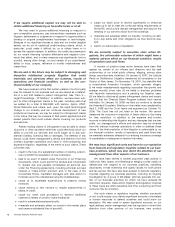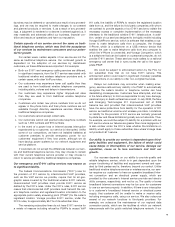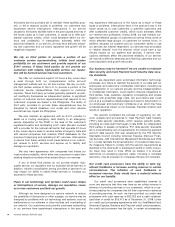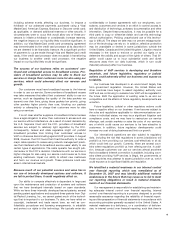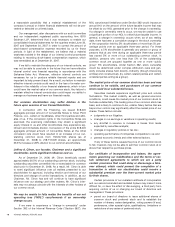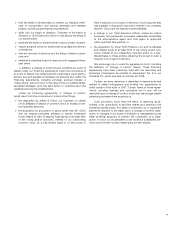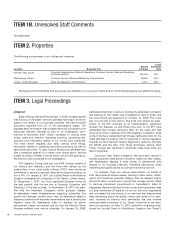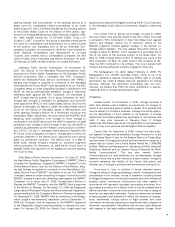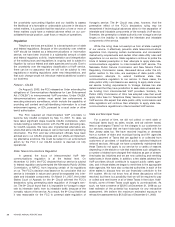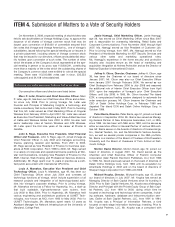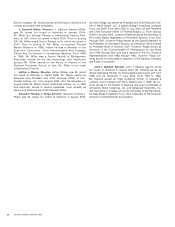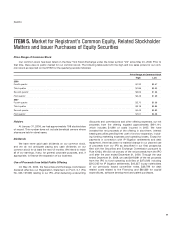Vonage 2008 Annual Report Download - page 21
Download and view the complete annual report
Please find page 21 of the 2008 Vonage annual report below. You can navigate through the pages in the report by either clicking on the pages listed below, or by using the keyword search tool below to find specific information within the annual report.launches ma
y
be de
f
erred or canceled as a result o
f
an
y
proceed-
ings, and we may be required to make changes to our present
and planned products or services. If, as a result of an
y
proceed-
in
g
s, a jud
g
ment is rendered or a decree is entered a
g
ainst us, it
m
ay materially and adversely affect our business, financial con
-
dition and results of o
p
erations and harm our re
p
utation.
Certain as
p
ects of our service are not the same as tradi-
tional tele
p
hone service, which ma
y
limit the acce
p
tanc
e
o
f
our services by mainstream consumers and our poten
-
tial
f
or growth.
For certain users, certain aspects o
f
our service are not the
s
ame as traditional telephone service.
O
ur continued growth i
s
dependent on the adoption of our services b
y
mainstream
customers, so these di
ff
erences are important. For example
:
>
B
oth our E-911 and emergency calling services are different
,
in si
g
nificant respects, from the 911 service associated wit
h
t
raditional wireline and wireless telephone providers and, i
n
certa
i
n cases, w
i
t
h
ot
h
er
V
o
IP p
rov
id
ers.
>
O
ur customers may experience lower call quality than they
are used to from traditional wireline telephone companies
,
including static, echoes and delays in transmissions.
>
Our customers may experience higher dropped-call rate
s
t
han they are used to from traditional wireline telephone
compan
i
es.
>
C
ustomers who obtain new phone numbers from us do no
t
appear in the phone book and their phone numbers are no
t
available through directory assistance services offered b
y
t
ra
di
t
i
ona
l
te
l
ep
h
one compan
i
es
.
>
Our customers cannot accept collect calls.
>
Our customers cannot call premium-rate telephone numbers
s
uch as 1-900 numbers and 976 numbers
.
>
I
n the event o
f
a
p
ower loss or Internet access interru
p
tion
exper
i
ence
db
y a customer, our serv
i
ce
i
s
i
nterrupte
d
.
U
n
lik
e
s
ome o
f
our competitors, we have not installed batteries at
customer premises to provide emergency power
f
or our
customers’ equipment if they lose power, althou
g
hwedo
h
ave backup power s
y
stems
f
or our network equipment and
s
ervice
p
lat
f
orm.
I
f customers do not acce
p
t the differences between our serv-
i
ce and traditional telephone service, the
y
ma
y
choose to remain
with their current telephone service provider or may choose t
o
r
eturn to serv
i
ce prov
id
e
db
y tra
di
t
i
ona
l
te
l
ep
h
one compan
i
es
.
Our emer
g
ency and E-911 callin
g
services may expose u
s
to signi
f
icant liability.
The Federal
C
ommunications
C
ommission
(
“F
CC
”
)
rules fo
r
t
he provision of 911 service b
y
interconnected VoIP providers,
s
uch as the VoIP service we provide, require that
f
or all
g
eo
-
graphic areas covered by the traditional wireline E-911 network,
i
nterconnecte
dV
o
IP p
rov
id
ers must
p
rov
id
e
E
-911 serv
i
ce a
s
defined b
y
the FCC’s rules. Under the FCC’s rules, E-911 service
m
eans that interconnected VoIP
p
roviders must transmit the call-
er’s telephone number and re
g
istered location information to th
e
appropriate public safety answerin
g
point (“PSAP”) for the caller’s
r
egistered location. Vonage provides E-911 service, under the
F
CC
’s rules, to approximately 99.1% of its subscriber lines
.
The remainin
g
subscriber lines do not have E-911 service
f
o
r
a variety of reasons including refusal by P
S
APs to accept VoIP
9
11 calls, the inability of PSAPs to receive the re
g
istered locatio
n
d
ata from us, and the failure by third party companies with who
m
w
e contract to
p
rovide as
p
ects of our E-911 service to obtain th
e
necessar
y
access or complete implementation o
f
the necessar
y
i
nter
f
aces to the traditional wireline E-911 in
f
rastructure. In addi-
tion, certain of our services desi
g
ned to be hi
g
hly mobile includin
g
V
ona
g
e SoftPhone service, which is software that enables a cus-
tomer to make telephone calls
f
rom a computer, the Vonag
e
V
-Phone, which is a softphone on a U
S
B memory device tha
t
e
nables the user to make telephone calls
f
rom an
y
computer t
o
w
hich the V-Phone is connected, and Vonage Companion, which
i
s a soft
p
hone that can be loaded on a
p
ersonal com
p
uter, do not
p
rovide E-911 service. These services route callers to a nationa
l
e
mergency call center that in turns routes the call to the appro-
p
riate P
S
AP.
W
e could be subject to enforcement action b
y
the FCC fo
r
o
ur su
b
scr
ib
er
li
nes t
h
at
d
o not
h
ave
E
-911 serv
i
ce.
This
e
nforcement action could result in si
g
nificant monetary penalties
a
nd restrictions on our abilit
y
to o
ff
er non-compliant services
.
D
e
l
ays our customers may encounter w
h
en ma
ki
ng emer-
g
ency services calls and any inability of a PSAP to automaticall
y
recognize the caller’s location or telephone number can have
d
evastating consequences.
C
ustomers have attempted, and ma
y
i
n the
f
uture attempt, to hold us responsible
f
or any loss, dama
g
e,
p
ersonal injur
y
or death su
ff
ered as a result. In Jul
y
2008, the New
a
nd Emerging Technologies 911 Improvement Act of 2008
b
ecame
l
aw an
d
prov
id
e
d
t
h
at
i
nterconnecte
dV
o
IP
prov
id
er
s
have the same protections
f
rom liabilit
yf
or the operation o
f
91
1
s
erv
i
ce as tra
di
t
i
ona
l
w
i
re
li
ne an
d
w
i
re
l
ess
p
rov
id
ers.
Li
m
i
tat
i
ons
o
n liability for the provision of 911 service are normally
g
overned
by
state law and these limitations t
y
picall
y
are not absolute. Thus,
for example, we could be subject to liability for a problem with our
9
11 service where our failures are
g
reater than mere ne
g
li
g
ence. It
i
s also unclear under the FCC’s rules whether the limitations on
li
a
bili
ty wou
ld
app
l
ytot
h
ose su
b
scr
ib
er
li
nes w
h
ere
V
onage
d
oe
s
not prov
id
e
E
-911 serv
i
ce
.
O
ur abilit
y
to
p
rovide our service is de
p
endent u
p
on third-
p
arty
f
acilities and equipment, the
f
ailure o
f
which coul
d
c
ause delays or interruptions o
f
our service, damage our
r
eputat
i
on, cause us to
l
ose customers an
dli
m
i
t our
g
rowth.
O
ur success depends on our abilit
y
to provide qualit
y
and
reliable telephony service, which is in part dependent upon th
e
p
roper functionin
g
of facilities and equipment owned and oper
-
a
ted b
y
third parties and is, there
f
ore, be
y
ond our control. Unlike
traditional wireline tele
p
hone service or wireless service, our serv
-
i
ce re
q
u
i
res our customers to
h
ave an o
p
erat
i
ve
b
roa
db
an
dI
nter-
net connection and an electrical power suppl
y
, which are
p
rovided by the customer’s Internet service provider and electric
utility company, respectively, and not by us. The quality of som
e
b
roadband Internet connections ma
y
be too poor
f
or customers
to use our services properly. In addition, i
f
there is any interruption
to a customer
’
s
b
roa
db
an
dI
nternet serv
i
ce or e
l
ectr
i
ca
lp
owe
r
s
upp
ly
,t
h
at customer w
ill b
e una
bl
etoma
k
e or rece
i
ve ca
ll
s,
i
ncluding emergency calls, using our service. We also outsourc
e
s
everal of our network functions to third-party providers. Fo
r
e
xample, we outsource the maintenance o
f
our re
g
ional data
c
onnection points, which are the
f
acilities at which our network
i
nterconnects with the
p
ublic switched tele
p
hone network. If ou
r
13


